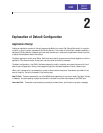
TYPE, is the type of Block to pass control to, there are five types of ACTIONS: GOTO, TRANSLATE, PASSWORD then
GOTO, SEARCH ON, and FILE.
The TARGET is the Name of the Block to pass control to next.
Modes
At any time of the day the SVMi-8 system is in a specific operating mode. This may be as simple as Day Mode
(business hours) or Night Mode (business closed) or it can be very complex (Special Mode for Port 2 Only, on July
19th between 7 and 8 p.m.). New modes may be added as needed. The times that operating modes are effective are
defined in the Schedule Table. The behavior of the SVMi-8 when it answers a new call during each specific operating
mode is defined in the Mode Block.
SVMi-8 can be made to change modes either manually, by using Special Administrative commands, or automatically
as specified in the Schedule Table.
Mode Specific Event Pointers
When programming any block that defines event targets (exit points from the block) the SVMi-8 will first ask you to
select a mode. This allows the exit destinations to be different for each mode.
For example, the next pointer might access an announcement informing callers of special daytime sales events dur-
ing the 'Day' Mode, but after 5:00 p.m., it would pass control to a different announcement about evening shopping
hours, during 'Night' Mode.
Pointers set in the 'Default' mode are always in effect unless the same pointer is set in another Operating Mode. The
SVMi-8 will display 'Default' mode pointers in a block while viewing pointers in another mode. The 'Default' mode
pointers will be grayed out to denote that they are not in the current mode.
Each Operating Mode is given an unique number by the system. Valid numbers are 01-99, and are assigned in
sequence as new modes are created. Pressing ENTER at this field opens a Pointer Mode Target Generator, from
which an existing mode name may be selected, or a new name may be entered. Entering a new name creates a new
Mode with its corresponding Number.
The mode number and name are associated with the block's pointers, not the block itself. This allows one block to
route calls to different destinations in different modes, using different Targets for the pointers' various mode refer-
ences.
Template Blocks
To simplify creating multiple blocks of a given type, SVMi-8 provides a template for each type of block. Templates
have default values preset for many of their parameters. You may change these defaults and save the modified
Template, or by using the 'Save As...' option , create a new block of that type, while preserving the original template.
Each time a block is created, it will be initialized with the parameter values which are set in the template. This is par-
ticularly useful when building mailbox and extension blocks for subscribers, where many of the parameter settings
will be uniform from subscriber to subscriber.
Explanation of Default Configuration
27


















